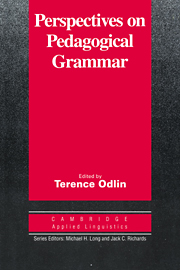Book contents
- Frontmatter
- Contents
- List of contributors
- Series editors' preface
- Preface
- Chapter 1 Introduction
- I WHAT SORT OF GRAMMAR?
- II GRAMMAR, LEXICON, AND DISCOURSE
- III PUTTING GRAMMAR TO WORK
- Chapter 9 The effect of systematic instruction on learning the English article system
- Chapter 10 Linguistic theory and pedagogic practice
- Chapter 11 The Introspective Hierarchy: A comparison of the intuitions of linguists, teachers, and learners
- Chapter 12 From printout to handout: Grammar and vocabulary teaching in the context of Data-driven Learning
- Chapter 13 Conclusion
- Glossary
- Index
Chapter 12 - From printout to handout: Grammar and vocabulary teaching in the context of Data-driven Learning
Published online by Cambridge University Press: 05 October 2012
- Frontmatter
- Contents
- List of contributors
- Series editors' preface
- Preface
- Chapter 1 Introduction
- I WHAT SORT OF GRAMMAR?
- II GRAMMAR, LEXICON, AND DISCOURSE
- III PUTTING GRAMMAR TO WORK
- Chapter 9 The effect of systematic instruction on learning the English article system
- Chapter 10 Linguistic theory and pedagogic practice
- Chapter 11 The Introspective Hierarchy: A comparison of the intuitions of linguists, teachers, and learners
- Chapter 12 From printout to handout: Grammar and vocabulary teaching in the context of Data-driven Learning
- Chapter 13 Conclusion
- Glossary
- Index
Summary
In this chapter I shall describe and illustrate on-going work that attempts to synthesise two approaches to language teaching – one basically traditional, and the other more innovative. The setting for the work is the insession programme of classes offered by the English for Overseas Students Unit at the University of Birmingham to overseas postgraduate students following courses and undertaking research in a wide range of subjects, from Production Engineering to Special Education and from Accountancy to Theology. Students who need help and encouragement can choose from a programme of classes, some of which are defined in terms of language form (e.g., Remedial Grammar, Pronunciation) and others in terms of language function (e.g., Academic Writing, Social Interaction). The form/function distinction is, however, not adhered to rigidly, and in all classes it is the form/function relationship that is the ultimate object of study in terms of the rules that determine the interpretation of form and those that govern the realisation of function.
Two examples may help to demonstrate the implications of Figure 1:
1. In the functionally defined academic writing class we emphasise the importance of indicating to the reader the extent to which the writer allies himself/herself with previous writers on the same topic, and in that context we look at the formal devices (e.g., syntactic choice of tense and lexical choice of reporting verb) by which that functional choice is realised.
- Type
- Chapter
- Information
- Perspectives on Pedagogical Grammar , pp. 293 - 313Publisher: Cambridge University PressPrint publication year: 1994
- 83
- Cited by



